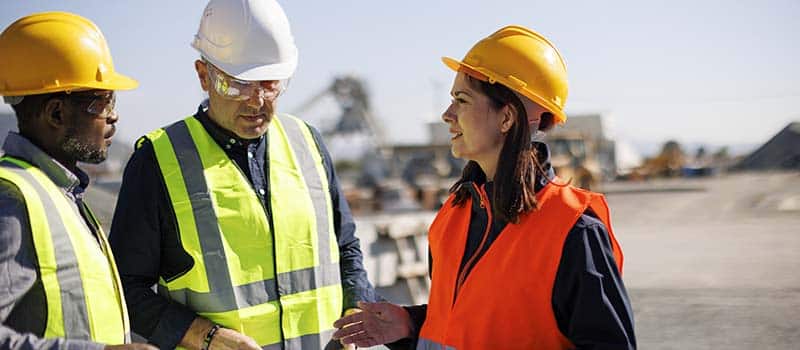The construction industry is shifting towards integrating technology in project management and operations – but this brings with it a heightened risk of cyber threats.
From project blueprints to confidential client data, every digital asset is a potential target, and as cyber threats evolve, the question looms: How well-protected are your digital assets against the sophisticated cyber threats of today?
This article will explore practical strategies to upgrade and strengthen your cyber security measures, ensuring that your valuable digital assets remain secure in an increasingly connected and vulnerable digital landscape.
The Growing Vulnerabilities of Digital Assets in Construction
While digital technologies deliver a wealth of benefits to construction companies – from enhancing efficiency and accuracy, to enabling real-time updates and project visualisation – this shift brings new challenges, particularly in data security.
The widespread use of mobile technology on sites, and the increasing integration of IoT devices in construction processes, introduce unique vulnerabilities that need specific attention in any cyber security strategy. Electronic blueprints, client databases, and communication systems are more vulnerable precisely because they are more accessible.
Safeguarding Digital Assets: Identify, Assess, Manage
Identifying and protecting your most critical digital assets is the cornerstone of your cyber security strategy. This is vital in focusing your resources effectively to guard against cyber threats.
- Identify Digital Assets: Identify your digital assets such as project designs, financial records, and client information. Understanding what constitutes your digital assets is the first step in protecting them.
- Assess Vulnerability: Once you know your assets, the next step is to assess their vulnerability. This involves understanding how these assets can be compromised and the potential impact of such incidents.
- Manage Risk Assessment: Implement a systematic risk assessment process by identifying potential threats, assessing the likelihood of these threats, and understanding the potential impact on your business. A well-conducted risk assessment not only highlights areas of vulnerability but also guides you in prioritising your cyber security efforts.
Secure Digitalisation: Key Steps to Strengthen Cyber Security in Construction
Strong password policies and stringent access controls form the bedrock of your cyber defences. Strong passwords should be made of 12 or more characters, and changed regularly. Role-based access controls allow users to access only the resources they need, keeping sensitive data accessible only to authorised personnel.
MFA adds an extra layer of security by requiring users to input two or more pieces of verification before they can access resources or accounts. According to Verizon’s Data Breach Investigations Report, 80% of hacking-related breaches leveraged either stolen passwords or used brute force.
Keeping software up-to-date is a simple yet powerful tool in preventing cyber-attacks. Regular updates and patch management close security loopholes and strengthen your cyber defences.
Scrambling sensitive information both at rest and in transit prevents unauthorised people from reading it, as it can’t be deciphered without the proper decryption key.
We delve into the importance of secure data storage solutions and robust backup strategies. This section guides you in implementing effective data backup plans, a critical component in recovering swiftly from a cyber attack.
Addressing the unique challenges posed by mobile devices and IoT technology on construction sites, we provide tailored strategies to secure these technologies against cyber threats.
Employees are often the first line of defence against cyber threats. A recent study by the Ponemon Institute found that organisations with employee cyber awareness training programs experience 70% fewer cybersecurity incidents than those without training. Educating your team about potential cyber risks and teaching them best practices can significantly reduce the likelihood of successful attacks.
Preparing for the Worst: Incident Response Planning
Identify key personnel who will form your incident response team. This team should include members from various departments such as IT, legal, HR, and public relations, to cover every aspect of your company
Not all cyber incidents are equal. Define what types of incidents your business might face, such as data breaches, ransomware attacks, or service outages. Prioritise these based on their potential impact on your operations and reputation.
For each type of incident identified, develop specific response procedures. This includes steps like isolating affected systems, assessing the extent of the breach, and notifying relevant stakeholders.
Effective communication is key during a cyber crisis. Establish clear protocols for internal communication within the response team and external communication with stakeholders, clients, regulatory bodies, and possibly the public.
Ensure that your response plan addresses legal and compliance issues. This includes understanding reporting obligations under Australian law and any industry-specific regulations, such as the Notifiable Data Breach scheme.
Maintain a list of contact information for external support, such as cyber security experts, legal counsel, and law enforcement. Quick access to these contacts can be vital during a crisis.
A plan is only as good as its execution. Regularly test your IRP with drills and ensure that all team members are trained and familiar with their roles and responsibilities.
Cyber threats are constantly evolving, and so should your IRP. Regularly review and update the plan to reflect new threats, technological changes, and lessons learned from drills or actual incidents.
Steadfast Solutions: Building a Cyber-Secure Future for Construction Companies
The construction industry’s digital transformation, while promising greater efficiency and innovation, also demands heightened vigilance and proactive measures in cyber security.
However, navigating this field is an ongoing commitment that requires industry knowledge and strategic solutions – which is where Steadfast Solutions comes in. We specialise in providing cyber security support and services for the construction industry, protecting your digital assets and data integrity from all manner of malicious entities.
Reach out to our team of cyber security experts for a consultation, and find out how we can strengthen your digital defences.




